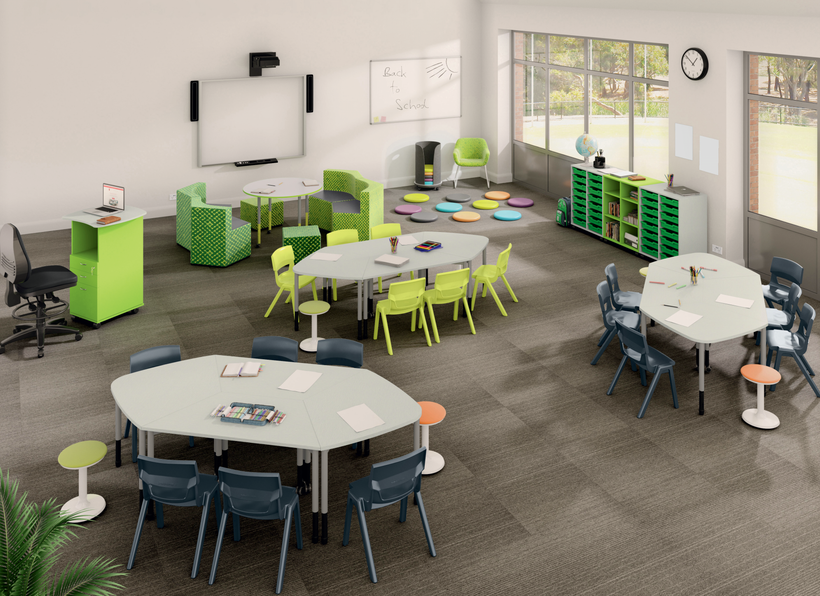Create an Effective Active Learning Environment?
by Wade Larkin on

What Is an Active Learning Environment?
Most educators will agree that one of the most significant teaching challenges in classrooms is maintaining an engaged audience. One of the most recent methods that has become widespread in the education sector is fostering an active learning environment. So, what is an active learning environment, exactly? How can you set up your classroom to engage your students? This article will cover all aspects of active education, including the definition, design, requirements, and benefits of dynamic spaces.
Defining an Active Learning Environment
Active learning is an approach to instructions provided within learning environments to encourage students to participate or interact with course material. It means that students gain the opportunity to be experientially or actively involved with the topics, rather than passively absorbing the information. There are numerous strategies that teachers can use to implement an active learning space. Fostering an active learning environment can be as simple as opening up more class discussions, allowing students to problem solve in groups, or using role plays to understand concepts.
How to Design an Active Learning Space
Classroom design plays a vital role in influencing students’ interaction and engagement, ultimately leading to improved retention. So, how should you design an active learning space to optimise your student’s experience?
The key to designing an active learning environment is to ensure that you create a welcoming environment with a flexible and open layout. Classrooms should feel clean and fresh, with comfortable furniture to keep students feeling physically and psychologically relaxed. Education spaces can also be serendipitous to minimise prescriptive or restrictive behaviours among both students and educators.
What Is Needed for An Active Learning Space Setup?
Now that we have defined ‘what is an active learning environment’, you’ve likely already thought of numerous ways to implement active education in the classroom. An active learning space setup is easy to achieve and amounts to far better results for students and teachers alike. According to research conducted by Herman Miller, “a significant opportunity exists for maximising learning opportunities and creating meaningful experiences by rethinking the classroom experience.” Considered classroom furniture is central to promoting a dynamic and flexible learning space. Below are some key furniture product ideas to inspire efficient and adaptable learning environment setups:
Multi-Purpose Seating
Thriving active learning environments will have adjustable and flexible furniture to create interactive spaces for students. Modular & soft seating is the most versatile way to furnish your classroom. Opting for versatile styles of seating means furniture suitable for both learning and breakout spaces. Soft seating that is intended for mutilple uses is also a clever way to foster a comfortable environment that will enchance the teaching and learning experience. Additionally, the Herman Miller Caper Multi-Purpose Stacking Chair range is lightweight, easy to move and can be stacked out of the way in a jiffy if you need to reconfigure the room quickly. Not only are they an agile piece for an active learning setup but they are also sure to brighten any education facility with a variety of inspiring colours.
Education Tables
Education & school tables should allow for ease of movement throughout the classroom. The Twist ’n’ Lock tables, by Australian manufacter Sebel, are perfect for an engaging classroom environment as they are fun, colourful and encourage collaboration. Children can sometimes have trouble focusing when sitting for long periods, just like us adults can. Having zones with high benches for students to do different tasks at or height-adjustable tables are an excellent way to breakup extended periods of sitting with some standing time to help regain focus.
Mobile Writing Boards
Just as your students have the freedom to move, educators should be able to adapt with them. Mobile whiteboards & writing boards which can easily wheel around the class allows educators to be front-and-centre of different groups of students, no matter where they are. Having the ability to interact with students during different activites and illustrate key points of a task is critical for maintaining classroom engagement.

SixE Learn
Encourage self-directed learning and keep busy minds focussed on the task at hand with the SixE Learn education chair. This chair is the epitome of contemporary classroom furniture, with a dynamic and multifunctional design. The SixE Learn encourages flexible, self-directed learning and collaboration to improve focus throughout the day.
The Benefits of Active Education
According to Herman Miller research, active learning settings lead to better knowledge acquisition, retention, accuracy, creativity in problem-solving, and higher-level reasoning. Creating a flexible and supportive classroom environment minimises distractions and promotes higher engagement levels. Perhaps most importantly, a vibrant learning atmosphere helps to prepare students for life outside of the classroom. The ability to work autonomously and participate in collaborative problem solving are among the most valuable skills an individual can bring to the workplace.
Implement an Active & Collaborative Learning Space
As an educator, your classroom’s ultimate goal should be to support the curriculum, encourage psychological and sociological growth, and enrich your students’ academic abilities. Above all, learning environments should promote a sense of wellbeing. NPS Commercial are Australia’s leading provider of commercial and ergonomic furniture in Townsville, North Queensland. We focus on providing great furniture that optimises the performance of every environment. Find out more about the best office furniture Townsville has to offer and get on the path to successful classroom engagement today.
